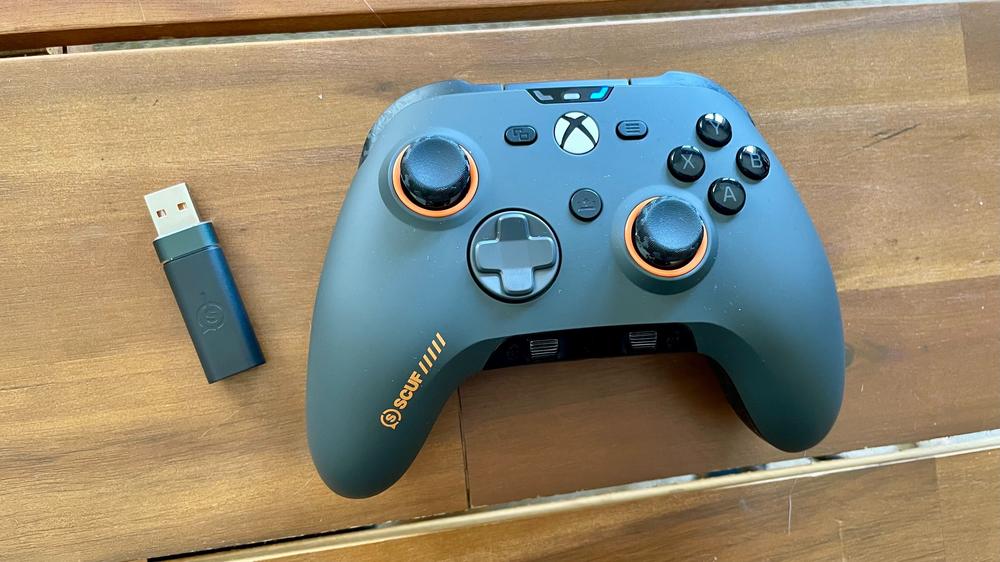Pro-style controllers are a dime-a-dozen nowadays, but Scuf has pioneered the third-party gamepad that comes with extraneous features that are supposed to give a competitive edge. Things like programmable back buttons, swappable thumbsticks, hair trigger stops, and finely tuned analog control can genuinely make for a better gameplay experience, particularly for competitive scenarios where precision and split-second inputs matter. With so many options already available, where does that leave the new Scuf Valor Pro? It’s in the smaller details.
While there are a few new additions that aren’t necessarily game-changing, like onboard volume-chat wheels (and an upcoming 1000Hz polling rate for PC users), what matters is how it iterates on familiar features to make them feel better to use. The wired version comes in at $100 while the wireless model goes for $190, and it's a tough ask even for those looking for something geared towards competitive play, but aside from a few quirks, it’s one of the better controllers for PC and Xbox.
Editor's note (10/22/25): This review, originally published on February 24, 2025, has been updated to reflect my experience using the new wireless model of the Scuf Valor Pro. A new section has been added to highlight it specifically as well.
Scuf Valor Pro – Design and Features
With this primarily being for Xbox, it takes on the same layout and similar ergonomics as the stock Xbox controller. Nearly across the board, however, every button has a better and more responsive tactile feel. The face buttons have a nice bounciness that makes them easier to tap rapidly, and the eight-way directional pad still has a distinct clickiness but it doesn’t have that stale crunch of the normal Xbox controller.
What’s arguably the biggest upgrade with the Valor Pro is the switch to magnetic Hall Effect analog sticks (and TMR on the wireless model). As the concern over stick drift on traditional controllers leaves folks burned by defective parts and expensive options for replacements, Hall Effect and TMR sticks have been increasingly common in high-end third-party gamepads. They’re much more durable since the magnetic parts create less friction, and it also feels great from a performance standpoint here on the Valor Pro.
Another noteworthy addition is the unique onboard volume and chat balance control. On the bottom next to the 3.5mm audio jack are two scroll wheels – the left one handles in-game volume and the right one controls chat volume. Many wireless gaming headsets have a volume-chat mix dial of their own, so the one on the Valor Pro is strictly for devices plugged into the audio jack. This limits its use-case somewhat, but can make things convenient for those who go with a wired analog headset.
As for the more minute details, the left and right bumpers have a great mouse-like click to them, making them much easier to press with a light touch while providing good tactility. The triggers are smooth and consistent all the way through so it’s easier to apply a specific amount of pressure. On the inner side of RT and LT are trigger stops to put the hair trigger mechanism in place – it creates a much shorter throw distance so you can theoretically actuate and reset trigger inputs faster.
Back paddles are key to any good pro-style controller and the four programmable buttons are decent, but not exactly my favorite of the many controllers I’ved used in the past. The two main buttons, labeled P1 and P2, sit along the inner side of the controller’s grips where your middle fingers would typically rest. While their positioning and tactility are great, they’re a tad too stiff for my liking – at least I never accidentally pressed them even with a tight handle on the controller.
The back buttons labeled P3 and P4 are interesting in that they’re more like hunches that sit closer to the center of the controller’s rear. You can either flick them with the backside of your middle finger or press down on them directly, which makes them easier to use than P1 and P2 thanks to their soft, mouse-click feel. If you only need two back buttons and/or find the inner P3 and P4 buttons to get in the way, you can easily remove them by plucking them out from the notch on the inner side.
The rubberized texture that lines the handles creates a firm and comfortable grip – with all these extra features and pieces built for performance, having a solid grip on a controller that has a decent weight brings it all together.
Scuf Valor Pro – Customization and Software
With Scuf being under the Corsair umbrella, it's a bit surprising that the Valor Pro doesn't use the iCue software suite on PC for manual configuration. It’s one of my least favorite software suites among the major peripheral manufacturers, so it's actually fine. Not having a customization app isn’t the end of the world since there just isn’t much to fiddle with on the Valor Pro. Mapping the back buttons is done easily on the controller itself – just hold down the profile button the back, press the back button and normal button you want to map together, and that’s it. You can even map d-pad directions and stick clicks in rare cases that would help more. The profile button swaps between three different settings (indicated by the LED color on the top right) so you don’t need to keep remapping things if you need specific setups for different games.
A post-launch update brought 1000Hz polling rate to PC users – polling rate refers to the frequency at which the controller sends registered inputs to the device it’s plugged into. High polling rates are increasingly common in gaming mice and keyboards, and there’s a theoretical advantage to that, and while I find polling rates over 1000Hz to bring a minimal to negligible benefit, bringing a controller to the 1000Hz standard helps it keep up with the input fidelity offered by higher refresh rate displays (if you use them).
Like other Scuf controllers, you can lift the Valor Pro’s faceplate off since it’s held in place magnetically. Customizing a faceplate is cool and all, but this is how you swap out the thumbsticks by just pulling them out. The normal concave-style sticks are on by default, but I quite like the convex-style sticks, especially since there’s a taller one I can use as the right analog stick to create more room for precise motions (which helps aiming in a shooter).

 “He lunged at me”: This musician fought off two home invaders using only his Owala water bottle
“He lunged at me”: This musician fought off two home invaders using only his Owala water bottle